 Website:
Magnetrol - AMETEK
Website:
Magnetrol - AMETEK
Group: AMETEK
Catalog excerpts
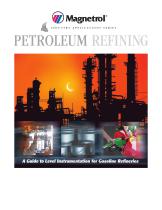
INDUSTRY APPLICATIONS
Open the catalog to page 1
COOLER ACCUMULATOR 20 Leading Petroleum Refinery Level Control Applications APPLICATION PAGE 2. Crude Dewatering 4 3. Crude Desalting 5 4. Preflash Drum 5 5. Distillation Column 6 6. Reflux Accumulator 6 7. Column Reboiler 7 8. Solvent Extraction 7 Conversion 9. Catalytic Cracker 8 10. Catalytic Stripper 8 11. Hydrocracking 9 12. Acid Settling Tanks 9 13. Alkylation Tanks 10 14. Catalytic Reformer 10 15. Coking Operations 11 16. Isomerization 11 Treatment 17. Hydrodesulfurization 12 18. Chemical Storage 12 Blending 19. Blending Unit 13 20. Finished Products 13 See page 14 for...
Open the catalog to page 2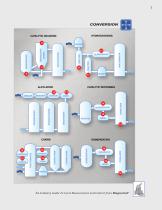
CATALYTIC CRACKING CONVERSION HYDROCRACKING CATALYTIC REFORMING An Industry Guide To Level Measurement and Control from Magnetrol®
Open the catalog to page 3
CRUDE STORAGE Application: Upon arrival at the refinery terminal, crude oil is pumped into above-ground storage tanks with capacities of thousands to millions of gallons. Raw crude is stored in floatingor fixed-roof tanks field-built to API standards. Tank level measurement by noncontact radar has gained share over mechanical float type and servo gauges due to its accuracy, low maintenance, no moving parts and fast set-up. Crude Tanks s Point Level: Model A15 DisplacerActuated Level Switch Challenges: Tank level is maintained by valve actuation. By triggering an emergency cutoff, level...
Open the catalog to page 4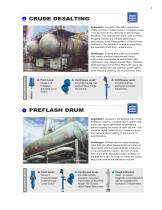
CRUDE DESALTING Application: Inorganic chlorides, suspended solids, and trace metals found in untreated crude must be removed by chemical or electrostatic desalting. This reduces the risk of acid corrosion, plugging, fouling and catalyst poisoning in downstream units. Measurement of the oil/water interface in the desalter is crucial in separating the cleansed crude from contaminants. Desalting Tanks s Point Level: Model A15 DisplacerActuated Level Switch Challenges: Coating and build-up on probes may create interface measurement errors. Instruments susceptible to electrostatic grid...
Open the catalog to page 5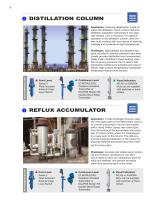
DISTILLATION COLUMN Application: Following desalination, crude oil enters the distillation column where fractional distillation separates hydrocarbons into separate streams, cuts or fractions. For optimum operation of the distillation column, level controls must contend with occurances of foaming, bubbling and moderate-to-high temperatures. Fractional Distillation s Point Level: Series 3 Float-Actuated External Cage Level Switch Challenges: Sight glasses and displacer systems mounted in external chambers have traditionally provided distillation level measurement. Today, radar retrofitted in...
Open the catalog to page 6
COLUMN REBOILER Application: A heat exchanger positioned near the bottom of the distillation column re-heats and vaporizes liquid and reintroduces the vapor several trays higher. This improves separation by introducing more heat into the column. For effective functioning of the reboiling process, level monitoring of the reboiler is required. s Point Level: Series 3 FloatActuated External Cage Level Switch or Tuffy® II FloatActuated Switch Challenges: In some steam reboilers, the level must be controlled so that only a percentage of tubes are covered. This allows a control scheme to regulate...
Open the catalog to page 7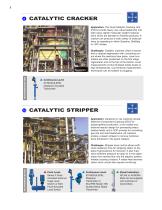
CATALYTIC CRACKER Application: The Fluid Catalytic Cracking Unit (FCCU) cracks heavy, low-value feedstocks into high-value, lighter molecular weight hydrocarbons which are blended to finished products. A cracker can produce a wide variety of yield patterns by operating in either Gasoline, Distillate or LPG modes. Challenges: Catalytic crackers utilize a reactor and a catalyst regenerator with connecting risers where the reactions take place. Level controllers are often positioned on the first stage regenerator and at the top of the reactor. Level measurements involve fluidized solids levels...
Open the catalog to page 8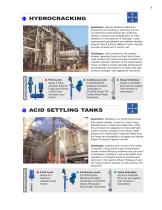
HYDROCRACKING Application: Heavier feedstock difficult to process by cat cracking or reforming can be converted by hydrocracking. By combining catalytic cracking and hydrogenation to crack feedstock in the presence of hydrogen, hydrocracking produces gasoline and distillate blending streams. About a dozen different hydro-cracking process schemes are in current use. Hydrocracking Unit Challenges: Level controls for the catalyst stripper, separator liquid and flash drum liquid must contend with severe process conditions to maintain optimum operation of the hydrocracker. These conditions...
Open the catalog to page 9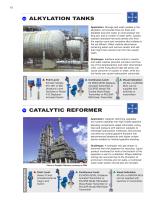
ALKYLATION TANKS Application: Storage and wash vessels in the alkylation unit include those for fresh and depleted acid and water, an acid analyzer settling pot, and a number of wash tanks. Caustic washes neutralize free acid carried over from the reaction zone and neutralize alkyl sulfates in the net effluent. Water washes decompose remaining esters and remove caustic and salt that might have carried over from the caustic wash. Wash Tanks Challenges: Interface level control in caustic and water washes prevents corrosion and fouling of the deisobutanizer and other downstream units. Levels...
Open the catalog to page 10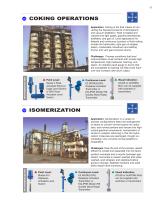
T5 COKING OPERATIONS Application: Coking is the final means of converting the heaviest products of atmospheric and vacuum distillation. Feed is heated and cracked into light gases, gasoline blendstocks, distillates, and gas oil. Level applications for delayed and continuous (contact or fluid) coking include the fractionator, light gas oil stripper, steam, condensate, blowdown and settling drums, and vent gas knockout drums. Challenges: Process conditions that level instrumentation must contend with include high temperatures, high pressures, foaming, and steam. An interface level gauge in...
Open the catalog to page 11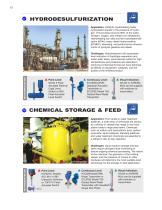
[7 HYDRODESULFURIZATION Application: Catalytic Hydrotreating treats hydrocarbon liquids in the presence of hydrogen. This process removes 90% of the sulfur, nitrogen, oxygen, and metals from feedstocks. Hydrotreating can also provide hydrodearomatization (HDAr), heavy diesel hydrocracking (HDHDC), dewaxing, and performance enhancements of pyrolysis gasoline and diesel. Challenges: Hydrotreatment will necessitate level indication of liquid/gas separators and water wash tanks. Level devices suited for high temperatures and pressures are essential in removing contaminants that can have...
Open the catalog to page 12All Magnetrol - AMETEK catalogs and technical brochures
-
Interface In The Field
14 Pages
-
Emulsion In The Field
9 Pages
-
PRODUCT LINE CATALOGUE
106 Pages
-
Aurora® Magnetic Level Indicator
28 Pages
-
Atlas™ Magnetic Level Indicator
24 Pages
-
STEAM DRUM LEVEL MATTERS
1 Pages
-
INTERFACE IN THE FIELD
1 Pages
-
Echotel® 355
4 Pages
-
Echotel® 335
4 Pages
-
Power Generation
16 Pages
-
Natural Gas Processing
12 Pages
-
Seal Pots
4 Pages
-
Mass Flow Measurement
12 Pages
-
Interface Level Measurement
8 Pages
-
Heat Rate Awareness
8 Pages
-
Ethylene Applications
8 Pages
-
Thermatel® TD1/TD2
16 Pages
-
Kotron® 082
4 Pages
-
Enhanced Jupiter®
16 Pages
-
GEMINI™
32 Pages
-
Aurora®
32 Pages
-
Atlas™
24 Pages
-
Horizon TM Model 704
8 Pages
-
Eclipse® Enhanced 705 Hygienic
12 Pages
-
Eclipse® Enhanced 705
8 Pages
-
Pneumatic Tuffy®
12 Pages
-
Models T5x & T6x
8 Pages
-
Models T20/T21
12 Pages
-
Series B73 and Series 75
12 Pages
-
Series 3
24 Pages
-
Model J52
2 Pages
-
Model B40
4 Pages
-
TUFFY® II
12 Pages
-
Digital E3 Modulevel®
12 Pages
-
Floating Roof Detection
16 Pages
-
APM Pneumatic Modulevel®
12 Pages
-
Flue Gas Desulferization
8 Pages
-
Energy Management
4 Pages
-
API 2350 Overfill Prevention
8 Pages
-
PULSAR ® R96
1 Pages
-
Water & Wastewater
12 Pages
-
Displacer Switches
20 Pages
-
Displacer Transmitters
4 Pages
-
Guided Wave Radar
12 Pages
-
Magnetic Level Indicators
12 Pages
-
Magnetostrictive
16 Pages
-
Pulse Burst Radar
8 Pages
-
Thermal Dispersion
12 Pages
-
Ultrasonic Contact
4 Pages
-
Vibrating Rod Switches
4 Pages
-
R Series High Temp Switch
12 Pages
-
Series K Pneumatic Switch
8 Pages
-
J Series Pneumatic Switch
8 Pages
-
Liquid Displacer Level Switches
16 Pages
-
Crude Oil Processing
8 Pages
-
Product Line Quick Reference
8 Pages





























































































